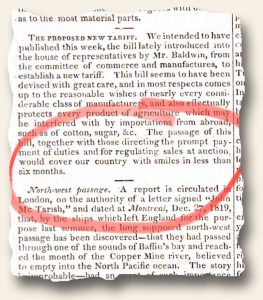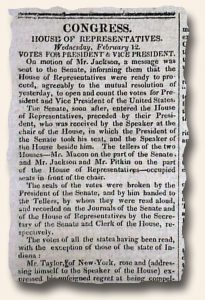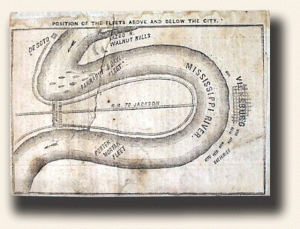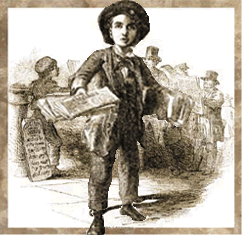Niles’ Registers from 1820 – unearthing interesting content (part 1)
December 17, 2020 by GuyHeilenman · Leave a Comment
Earlier this year Timothy Hughes Rare & Early Newspapers offered free issues of 200-year-old Niles’ Registers with a request for collectors to let us know if they found interesting, historical or unusual content within the issue they received. Below is the 1st installment of their “finds”. Enjoy.
 Collector L.D. from New Jersey –
Collector L.D. from New Jersey –
“Niles’ Weekly Register” – April 1, 1820.
Located on the front page.
Well I can’t say that I’m an expert on 1820s vernacular, I read this article from the edition I received and it seems (more than) a bit odd. “Covering the country with smiles” sounds like something that would’ve been said in today’s way of speaking, but not something that would’ve been said 200 years ago. Thoughts?
Collector J.T. from Georgia –
“Niles’ Weekly Register” – November 11, 1820.
In the “Foreign Articles” section Page 15 of 16.
Interesting find – News of the suicide of the first and last King of Haiti.
“HAYTI”
“King Henry has committed suicide by blowing out his brains. One account says that he did the deed in July, and that the event was kept secret to secure the succession of his son; and another that it happened about the 1st of October. But it seems certain that he is dead. He had been struck with a paralytic, and no longer able to command his troops, they became mutinous, and revolted at St. Marks – he ordered five regiments to march and punish the insurgents — they refused, and then his kingship made his exit. A body of 6000 troops……. etc.”
Wikipedia History reports that, “His son and heir was assassinated 10 days later.”
For historical references see: https://m.youtube.com/watch?v=q7lfSjjMNU8
and
https://www.britannica.com/biography/Henry-Christophe “… He built the famous Citadelle Laferrière, a fortress south of his capital at Cap-Haïtien. In August 1820 he suffered a paralytic stroke. When his condition was learned, revolts broke out. In despair over his failure to pacify the country, he shot himself at Sans-Souci palace (the citadel and palace were designated UNESCO World Heritage sites in 1982), and his kingdom became part of the Haitian republic in 1821. …”
Also: https://en.wikipedia.org/wiki/Henri_Christophe
Still Learning…Website Topical Searches
July 6, 2020 by Stephanie Williams · Leave a Comment
While working on a different topic, I came across a derogatory reference to California gold, which started me thinking of how little I know concerning that period in American history. I was born into the Information Age so there is no reason for me to remain in ignorance; the world wide web is packed with timelines and maps and diary excerpts. Since I work in a place that houses many original pieces concerning every era since the first colonists arrived, I decided to begin my research on the Rare Newspapers site.
 By merely typing “Gold Rush” in the search bar, I accessed 122 titles. As an experiment I only used the items and listing descriptions to obtain an overall working knowledge, and for entertainment purposes I thought it might be interesting to summarize my findings.
By merely typing “Gold Rush” in the search bar, I accessed 122 titles. As an experiment I only used the items and listing descriptions to obtain an overall working knowledge, and for entertainment purposes I thought it might be interesting to summarize my findings.
Modifying my results to an issue date sort, and beginning with the oldest first, I found the following attached to a paper dated September 28, 1848:
Page 3 has a lengthy article: “The Gold Region of California” which is from the very early period of the Gold Rush. It is mostly taken up with two letters from the gold fields, introduced with: “It would seem from late accounts that California is afflicted with some rich gold mines. The people there have been seized with madness on the subject & are abandoning the ordinary pursuits of life for the sake of hunting gold…”
Listings for publications from October, November and December of that year bear similar accounts and tell of the growing numbers of those involved. By January of 1849 the tone becomes cautionary:
Page 2 has: “California” which warns those thinking of heading to the gold fields to be very careful: “…large number of persons making preparations to proceed to El Dorado…will be obliged to undergo much suffering before reaching their wished-for haven & many will perhaps die on the passage…” with more. Also a short bit: “Death at the Gold Regions”.
Reading through all the write-ups I felt a bit more sure of my historical bearings when I encountered a familiar name that was not in this instance attached to a favorite brand of coffee (Pike’s Peak).
THE WASHINGTON UNION, Washington, D.C., August 29, 1858
* Pike’s Peak gold discovered
* Cherry Creek
* Start of Colorado gold rush
A page 2 report headed “Newly Discovered Gold Mines” says: “Monsieur Borden and company have arrived in Kansas City, from Pike’s Peak, Nebraska Territory. He reports newly discovered mines. He brought with him several ounces of gold, and confirms the existence of gold mines on Cherry Creek, branch south Platte; latitude 39”
It seems I have barely scratched the surface…
The Traveler… Election tension – should Indiana’s votes be counted?
February 20, 2017 by The Traveler · Leave a Comment
 Today’s journey took me to New York City by the means of the New-York Spectator, February 22, 1817. Under the heading of “Congress”, I found the “Votes for President & Vice President” report: “The votes of all of the states having been aloud, with the exception of those of the state of Indiana… One motion of Mr. Jackson, a message was sent to the Senate, informing them that the House of Representatives were ready to proceed, agreeably to the mutual resolution of yesterday, to open and count the votes for President and Vice President of the United States…The reading of the votes was then concluded and the tellers handed a statement thereof to the Present of the Senate… The president of the Senate then declared JAMES MONROE, of Virginia, to be duly elected President of the United States , and DANIEL D. TOMPKINS, of New York, duly elected Vice-President…”. A fair question to ask would certainly be: “Why were Indiana’s votes not included in the oral record?” An appropriate follow-up might be: “Were they eventually included?” If you know the answers off the top of your head, please respond. It sure is a good thing the election wasn’t close enough for Indiana’s votes to make a difference in the final result. However, the decision as to whether or not to include the votes was still an important one in regards to establishing precedent.
Today’s journey took me to New York City by the means of the New-York Spectator, February 22, 1817. Under the heading of “Congress”, I found the “Votes for President & Vice President” report: “The votes of all of the states having been aloud, with the exception of those of the state of Indiana… One motion of Mr. Jackson, a message was sent to the Senate, informing them that the House of Representatives were ready to proceed, agreeably to the mutual resolution of yesterday, to open and count the votes for President and Vice President of the United States…The reading of the votes was then concluded and the tellers handed a statement thereof to the Present of the Senate… The president of the Senate then declared JAMES MONROE, of Virginia, to be duly elected President of the United States , and DANIEL D. TOMPKINS, of New York, duly elected Vice-President…”. A fair question to ask would certainly be: “Why were Indiana’s votes not included in the oral record?” An appropriate follow-up might be: “Were they eventually included?” If you know the answers off the top of your head, please respond. It sure is a good thing the election wasn’t close enough for Indiana’s votes to make a difference in the final result. However, the decision as to whether or not to include the votes was still an important one in regards to establishing precedent.
~The Traveler
The tension revealed between Halloween and All Saint’s Eve…
October 28, 2016 by GuyHeilenman · Leave a Comment
Who decides what is right and what is wrong – what is evil and what is good? Is it man – and therefore a moving target based upon a majority view, or is it static – absolute, established by a Supreme Being who calls the shots? Is truth relative, or fixed? This philosophical question has been debated since the dawn of time. If the answer is “man”, then we had better get “it” right, or the consequences to the human race could be catastrophic. If the answer is a Supreme Being, then  the debate is meaningless – regardless of who comes out on top.
the debate is meaningless – regardless of who comes out on top.
Whereas most historic newspapers printed in Europe and the United States have shown to be rooted in a Judaeo-Christian ethic which promotes the latter view, one 19th-century Chicago title stands out as having embraced the former – elevating itself to a position of being a bearer of self-determined truth. There is no doubt the identification with another bearing this name is no accident. Read for yourself what it says about itself, and make your own decision as to the truthfulness of its claims:
Of course if the latter answer (Supreme Being) is correct, your (and my) opinion as to whether its claims are true will have no bearing on the truth. 🙂
Topsy the elephant… Thomas Edision vs. Nikola Tesla…
April 18, 2012 by GuyHeilenman · Leave a Comment
 Each day at Rare Newspapers brings new discoveries. Today we found an item which is quite historic. In 1903, the battle between Thomas Edison and Nikola Tesla (and Westinghouse) as to which form of electrical current (DC or AC) was to become the standard, was largely decided – with Edison’s DC current being the loser. Not willing to give up without a fight, Edison attempted to win public and political support by stressing the greater danger of death by electrocution from contact with AC current. In a highly publicized dramatic event, Edison organized and helped supervise the filming and electrocution by AC current of Topsy, a Coney Island circus elephant which had recently killed three men. While the execution was successful, and was overseen by the Society for Prevention of Cruelty to Animals, Edison was highly criticized for the event which did not accomplish his desired goal. The report was found on the front page of the ALLEGHENY COUNTY REPORTER, Wellsville, New York, January 6, 1903. I wonder if the S.P.C.A. would support such an action today?
Each day at Rare Newspapers brings new discoveries. Today we found an item which is quite historic. In 1903, the battle between Thomas Edison and Nikola Tesla (and Westinghouse) as to which form of electrical current (DC or AC) was to become the standard, was largely decided – with Edison’s DC current being the loser. Not willing to give up without a fight, Edison attempted to win public and political support by stressing the greater danger of death by electrocution from contact with AC current. In a highly publicized dramatic event, Edison organized and helped supervise the filming and electrocution by AC current of Topsy, a Coney Island circus elephant which had recently killed three men. While the execution was successful, and was overseen by the Society for Prevention of Cruelty to Animals, Edison was highly criticized for the event which did not accomplish his desired goal. The report was found on the front page of the ALLEGHENY COUNTY REPORTER, Wellsville, New York, January 6, 1903. I wonder if the S.P.C.A. would support such an action today?
The Traveler… it does what?… make them stop!!!
March 19, 2012 by The Traveler · Leave a Comment
 Today I made a return trip to Carlisle, Pennsylvania, via the Valley Sentinel from March 19, 1912, where I found Frank Coffyn had an aeroplane which was able to not only fly, but swim and crawl! It had also been used to take aerial photographs of the islands and shipping harbors of New York City. With the fitting of aluminum pontoons, it enabled the plane to float on the
Today I made a return trip to Carlisle, Pennsylvania, via the Valley Sentinel from March 19, 1912, where I found Frank Coffyn had an aeroplane which was able to not only fly, but swim and crawl! It had also been used to take aerial photographs of the islands and shipping harbors of New York City. With the fitting of aluminum pontoons, it enabled the plane to float on the  water and power along the ice floes in the Hudson. In researching Mr. Coffyn, I found that Wilbur Wright invited him to Dayton, Ohio, where he began flight instruction in 1910.
water and power along the ice floes in the Hudson. In researching Mr. Coffyn, I found that Wilbur Wright invited him to Dayton, Ohio, where he began flight instruction in 1910.
Another article is one in which Mr. Bentz had instantly killed Mr. Rozuski out of a fit of jealousy over an engagement. After the shooting, Mr. Bentz threw the revolver away. However, a group of small boys saw him running away… and a 12-year-old, acting as the head of the young “posse”, picked up the revolver and pursued Mr. Bentz for over a mile while firing the remaining bullets at him. Finally, the fatigued Mr. Bentz fell to his knees and begged them for no harm. They turned him over to the police. This almost sounds like a scene from the “Lil’ Rascals”!
~The Traveler
Confederate “Extra” with content from two eras…
April 18, 2011 by TimHughes · Leave a Comment
 Finding oddities from the newspaper world is part of the fun of the hobby, and recently one came our way which I found to be very unusual.
Finding oddities from the newspaper world is part of the fun of the hobby, and recently one came our way which I found to be very unusual.
The “Daily Appeal–Extra” newspaper from Memphis, Tennessee dated April 20, 1861, contains content which is over two years apart. This is a “broadside extra” edition meaning the narrow sheet was published to report a specific event, and printed on one side only. But in this case, the reverse is not entirely blank.
First, it’s curious that this is a newspaper from a city which was only “Confederate” until the battle of Memphis, June 6, 1862, after which it was in Yankee control. The front has a very nice graphic devise at the top of the first column showing a cannon and Confederate flag, with heads: “THE WAR NEWS ! ” “Star of the West Taken As A Prize ! “and other related heads & reports.
But the most intriguing aspect of this issue is the back page. Although I am convinced this was issued in 1861 with the reverse blank, it nonetheless has a print of a map of the Vicksburg vicinity, and nothing else. Now, let’s keep in mind that the siege of Vicksburg didn’t happen until mid-May, 1863 thru its fall to the Yankees on July 4, 1863. Note that the heading of the map reads: “Position of the Fleets Above and Below The City” showing the positions of both Porter’s and Farragut’s fleets. Their appearance in the Mississippi did not happen until 1863. I surmise this “Extra” edition was lying around the printing office and since the back side was blank they used it as a test sheet for printing this map, which likely appeared in a the “Memphis Appeal” newspaper at some point in May, June, or July, 1863. Consequently this becomes a truly fascinating curiosity to have printings from two different periods in a single issue, and one being a map.
Do any fellow collectors have another explanation?
Top 10 lists…
December 3, 2009 by GuyHeilenman · Leave a Comment
Top 10 lists are always fun to consider. Their strength is in their ability to generate thought, reflection, and opinion. We all acknowledge that no two top ten lists are the same, and whereas going to experts in the field may add a certain level of credibility to a list, even an amateur/novice can bring food for thought to the discussion. Everyone has an opinion, and each and every opinion has some some value. In the end, the greatest benefit may well be in the journey traveled as we formulate and consider both our own views as well as the views of others.
It is with this in mind we plan to offer 4 top ten lists over the course of the next four Mondays. The focus will be on giving thought to the top ten most historic newspapers from each of the following eras: 17th century and earlier (12/7/2009), 18th century (12/14/2009), 19th century (12/21/2009), and 20th century & beyond (12/28/2009). In some cases we may choose a specific newspaper title (any date), realizing that having any issue of the title is of note. In other instances we may focus on a specific title and date of a newspaper – these being the “holy grails” of the hobby. Yet in other cases we’ll include a more general top ten entry, focusing on the event itself, acknowledging that finding any newspaper coverage of the event is noteworthy.
As we proceed through the month, we invite both reactions to our lists and the submission of your own “top tens”.
 In an effort to help kick-start your walk into the past, we invite you to enjoy a recent post which appeared on OnLineSchool.net titled, “100 Great Moments in American History You Can Catch on YouTube”, by Amber Johnson: (http://onlineschool.net/2009/11/18/100-great-moments-in-american-history-you-can-catch-on-youtube/).
In an effort to help kick-start your walk into the past, we invite you to enjoy a recent post which appeared on OnLineSchool.net titled, “100 Great Moments in American History You Can Catch on YouTube”, by Amber Johnson: (http://onlineschool.net/2009/11/18/100-great-moments-in-american-history-you-can-catch-on-youtube/).
Most Popular History’s Newsstand Posts – January 2023 update
February 3, 2023 by GuyHeilenman · Leave a Comment
 Whereas some posts are time-sensitive, others have staying power. Although the History Newsstand Blog (sponsored by RareNewspapers.com) has been operating for nearly 15 years and has thousands of entries, certain posts have consistently appeared in the “Top Ten Most Popular Posts” list shown on the right-side menu. The top half-dozen as of this post are:
Whereas some posts are time-sensitive, others have staying power. Although the History Newsstand Blog (sponsored by RareNewspapers.com) has been operating for nearly 15 years and has thousands of entries, certain posts have consistently appeared in the “Top Ten Most Popular Posts” list shown on the right-side menu. The top half-dozen as of this post are:
- Do Old and Antique Newspapers Have Any Collectible Value?
- Setting values for collectible newspapers…
- Genuine or reprint?
- Framing and Storing Newspapers… the ongoing story…
- More on printing newspapers in the 1700’s…
- More on printing newspapers in the 1700’s…
- The reprint issues of the “Honolulu Star-Bulletin” Pearl Harbor issue…
In regard to the most popular (Do Old and Antique Newspapers Have Any Collectible Value?), if you ever have an old newspaper and are curious as to its potential (approximate) value, please contact us directly (info@rarenewspapers.com) as we do not respond through the post itself.
Were you there – 1980? Elton John performs in Central Park…
September 16, 2019 by GuyHeilenman · Leave a Comment
Price being equal, would you typically choose a tangible gift, or an experience? Why do I ask?
Context: My wife and I have been blessed with 6 children. As each approached the end of their high school education, we offered each of them a sizeable (to us – the parents of a large family with only one of us working outside the home) amount of money as a graduation gift, or its equivalent in cost to go on a trip of their own creation. Two of them opted for the $$$ to put toward items they wanted (at the time), while the other four each elected to go on a trip. Many years later, as we all reflect back on the “gifts”, those who chose the “experience” are pleased they did – and have vivid fond memories, and the others struggle to remember what it was they had purchased. The reality is, “things” are typically for the moment, and have short life-spans, whereas memories are for a lifetime.
It is with this in mind we embark on a new, experiential series of posts: “Where you there?” Our hope is that in so doing, those of you who were present will be flooded with good memories of your experience. To kick things off…
On September 13, 1980, Elton John performed a free concert in Central Park, New York. To this day, it remains one of the top ten most-highly attended musical events held in Central Park. Were you there? The ad below was printed in the September 9th, 1980 (f0r the 10th-16th) issue of The Village Voice. Feel free to share your family-friendly memories.


